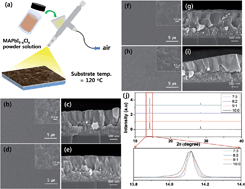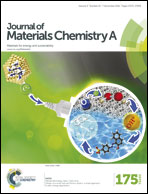Highly efficient CH3NH3PbI3−xClx mixed halide perovskite solar cells prepared by re-dissolution and crystal grain growth via spray coating†
Abstract
We fabricated highly efficient planar type CH3NH3PbI3−xClx (MAPbI3−xClx) mixed halide perovskite solar cells via spray coating with a controlled composition of the solvents. The cells had a power conversion efficiency of 17.8% (forward scan), 18.3% (reverse scan), and 16.08 ± 1.28% (average) for unit cells under 1 Sun conditions. We controlled the ratio of DMF (dimethylformamide), a quickly evaporating solvent, and GBL (γ-butyrolactone), a slowly evaporating solvent, to 10 : 0, 9 : 1, 8 : 2, and 7 : 3 (vol : vol). We obtained the largest MAPbI3−xClx mixed halide perovskite crystal grains in the 8 : 2 sample because the inward flux of the spray solution was balanced with the outward flux of the evaporating solvent. Consequently, the moistened underlying polycrystalline perovskite film with small crystal grains re-dissolved and merged into larger crystalline grains by re-crystallization. By controlling the re-dissolution and crystal grain growth of the MAPbI3−xClx mixed halide perovskite film via spray coating, we fabricated a sub-module (10 cm × 10 cm, active area = 40 cm2) with 10.5 V open circuit voltage, 84.15 mA short circuit current, 70.16% fill factor, and 15.5% power conversion efficiency under 1 Sun conditions.


 Please wait while we load your content...
Please wait while we load your content...